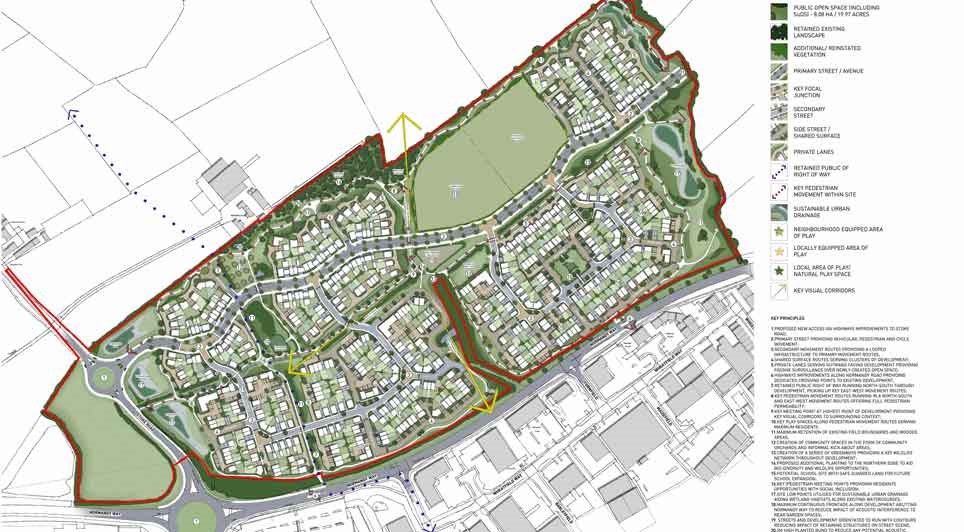Construction News
14/10/2011
Innovative Method Successfully Used To Insulate Historic House
Following a recent trial at the Bogendollo House in Aberdeenshire, an innovative method was successfully used to insulate an internally-lined solid masonry wall without causing damage to the historic features of the wall.
The method involved using water blown foam, developed by Canadian company Icynene Inc. This is the first time such insulation has been used in an historic building in Scotland. The water blown foam was created specifically for injecting into delicate structures. The foam expands slowly putting little pressure on the fragile inner wall and, as it is 100 percent water blown, it contains no harmful blowing agents. Additionally, through its open cell structure, the foam will allow the wall to breathe which will assist in controlling moisture movement.
Dr. Amar Bennadji, Principle Investigator of the project and lecturer in Architectural Technology at Robert Gordon University (RGU) Aberdeen stated that "following the successful trial, the heat loss through the wall was reduced by approximately 50 per cent". He explained that "this project opens the door for historic buildings to finally retain warmth, reduce their energy bills and contribute to efforts to curb global warming by reducing their carbon footprint." He further added that "the project team aims to pursue further work to improve historic building components, such as solid floors and sash windows."
Jeff Hood, Icynene's Vice-President flew in from Canada to Scotland to witness the trials. He said: "as a pioneer of the Green Building movement Icynene has developed non-destructive techniques of insulation that have been successfully used in historic buildings in North America for a number of years". He added that "We were very keen to observe and advise on the first test of this technology in the UK as until now there wasn’t a procedure available which could be used to insulate internally-lined solid masonry walls. The performance of the wall will be observed and monitored over the coming months."
"The success of this trial is highly significant for owners of historic houses and indeed registered social landlords who also have old housing stock with cavity walls," said Simon Falkner-Lee, Icynene's UK-based spokesperson. He explained that "the trial shows conclusively that Icynene's insulation system can be introduced into the wall cavity enabling our old and our historic houses to retain their heat whilst fully preserving their original features."
The technique called for a bead of Icynene's quick drying spray foam to seal the cavity along the bottom of the wall. Once this cavity was closed off, the pour foam was carefully injected from the attic area above.
"The success of this insulation trial has significant implications given that there are more than 400,000 historic listed buildings throughout the UK which, under new European regulations, are required to be insulated in order to make energy and carbon savings," added Mr Falkner-Lee.
The trial was carried-out through a project that was funded by the European Regional Development Fund and the SEEKIT programme of the Scottish Government under the Construction Improvement Club (CIC) scheme. The project was completed in collaboration with Craigie Levie (Architect and lecturer at RGU) and Dr Mohamed Abdel-Wahab (lecturer in Construction Management and Technology at Heriot-Watt University in Edinburgh).
The project is multi-disciplinary as it is not only limited to testing an innovative method for cavity wall insulation, but also it captures the implications for skills development and training. The insulation was installed by Kishorn Developments, an Icynene approved installer, supported by the Scottish distributor - GMS Renewable Products.
Dr. Abdel-Wahab said "this multi-disciplinary project presents a unique opportunity for providing actual project-based information on the skills requirements for successful wall insulation in historic buildings". He explained that "such information is crucial for providing guidance to government skills policy in support of the retrofitting of historic buildings."
The house owners, Mr and Mrs. Gibbons-Wood, are pleased with the project outcomes so far. Mr Gibbons-Wood said "I am hoping for the long-term success of the project and to insulate the whole house whilst maintaining its original features. I am reluctant to commit anymore investment in renewable energy without an insulated house."
The method involved using water blown foam, developed by Canadian company Icynene Inc. This is the first time such insulation has been used in an historic building in Scotland. The water blown foam was created specifically for injecting into delicate structures. The foam expands slowly putting little pressure on the fragile inner wall and, as it is 100 percent water blown, it contains no harmful blowing agents. Additionally, through its open cell structure, the foam will allow the wall to breathe which will assist in controlling moisture movement.
Dr. Amar Bennadji, Principle Investigator of the project and lecturer in Architectural Technology at Robert Gordon University (RGU) Aberdeen stated that "following the successful trial, the heat loss through the wall was reduced by approximately 50 per cent". He explained that "this project opens the door for historic buildings to finally retain warmth, reduce their energy bills and contribute to efforts to curb global warming by reducing their carbon footprint." He further added that "the project team aims to pursue further work to improve historic building components, such as solid floors and sash windows."
Jeff Hood, Icynene's Vice-President flew in from Canada to Scotland to witness the trials. He said: "as a pioneer of the Green Building movement Icynene has developed non-destructive techniques of insulation that have been successfully used in historic buildings in North America for a number of years". He added that "We were very keen to observe and advise on the first test of this technology in the UK as until now there wasn’t a procedure available which could be used to insulate internally-lined solid masonry walls. The performance of the wall will be observed and monitored over the coming months."
"The success of this trial is highly significant for owners of historic houses and indeed registered social landlords who also have old housing stock with cavity walls," said Simon Falkner-Lee, Icynene's UK-based spokesperson. He explained that "the trial shows conclusively that Icynene's insulation system can be introduced into the wall cavity enabling our old and our historic houses to retain their heat whilst fully preserving their original features."
The technique called for a bead of Icynene's quick drying spray foam to seal the cavity along the bottom of the wall. Once this cavity was closed off, the pour foam was carefully injected from the attic area above.
"The success of this insulation trial has significant implications given that there are more than 400,000 historic listed buildings throughout the UK which, under new European regulations, are required to be insulated in order to make energy and carbon savings," added Mr Falkner-Lee.
The trial was carried-out through a project that was funded by the European Regional Development Fund and the SEEKIT programme of the Scottish Government under the Construction Improvement Club (CIC) scheme. The project was completed in collaboration with Craigie Levie (Architect and lecturer at RGU) and Dr Mohamed Abdel-Wahab (lecturer in Construction Management and Technology at Heriot-Watt University in Edinburgh).
The project is multi-disciplinary as it is not only limited to testing an innovative method for cavity wall insulation, but also it captures the implications for skills development and training. The insulation was installed by Kishorn Developments, an Icynene approved installer, supported by the Scottish distributor - GMS Renewable Products.
Dr. Abdel-Wahab said "this multi-disciplinary project presents a unique opportunity for providing actual project-based information on the skills requirements for successful wall insulation in historic buildings". He explained that "such information is crucial for providing guidance to government skills policy in support of the retrofitting of historic buildings."
The house owners, Mr and Mrs. Gibbons-Wood, are pleased with the project outcomes so far. Mr Gibbons-Wood said "I am hoping for the long-term success of the project and to insulate the whole house whilst maintaining its original features. I am reluctant to commit anymore investment in renewable energy without an insulated house."

06/02/2025
Work has officially begun on Burleyfields Primary School, a new educational facility set to open in Stafford for the 2025/26 academic year.
The school, located on Martin Drive, will be part of the Creative Learning Partnership Trust, helping to meet the growing demand for school places in the area

06/02/2025
Small businesses in the Tees Valley are set to benefit from new office and commercial space at the Teesworks site, following planning approval from Redcar & Cleveland Council.
Teesworks Ltd has secured permission to develop more than 40 hybrid commercial units of varying sizes on the 4,500-acre sit

06/02/2025
The Hill Group and Lloyds Living have celebrated a major milestone in the construction of Nexus, a 264-home Build-to-Rent (BTR) development in Stevenage town centre, with a traditional topping out ceremony.
This marks the highest point of construction for the project, which is Hill's first BTR ven

06/02/2025
Housebuilder The Hill Group and Sovereign Network Group (SNG) are expanding their strategic investment partnership to accelerate the delivery of much-needed new homes across England.
The Sovereign Hill Partnership, formed in November 2023, has proven to be a highly successful model of joint ventur

06/02/2025
Construction is now underway on a £23 million refurbishment project to create a new specialist education school for Coventry City Council at the former Woodlands School site.
Clegg Construction has begun the redevelopment at the Broad Lane, Eastern Green location. The new facility will provide much

06/02/2025
Network Rail has entered the next phase of construction on the Mid Cornwall Metro (MCM), a transformative project designed to enhance coast-to-coast rail travel in Cornwall.
Funded by the UK Government and Cornwall Council, the MCM is being delivered in partnership with Great Western Railway (GWR).

06/02/2025
A major milestone has been reached in the construction of Lighthaus, Starlight Investments' flagship build-to-rent (BTR) development in Liverpool Waters, as partners Starlight Investments, X1, Vermont and Peel Waters celebrated its topping out ceremony.
Standing 31 storeys tall, Lighthaus is set to

06/02/2025
Vistry Group has secured a 16-acre site in Bulkington, near Bedworth, with plans to build 149 new family homes.
The development, named St James Gate, has received full planning permission from Nuneaton and Bedworth Borough Council and will bring a mix of one-, two-, three-, and four-bedroom homes

05/02/2025
Stockport Mayoral Development Corporation (MDC) and ECF, a joint venture between Homes England, Legal & General, and Muse, have selected Vinci as the preferred contractor for Phase 1 of Stockport 8, a £350 million residential development west of Stockport town centre.
The decision follows a competi

05/02/2025
Vistry Group has finalised contracts for a significant housing development in Hinckley, Leicestershire, securing outline planning permission to deliver 475 new homes in the area.
The development, located east of Stoke Road and north of Normandy Way in the town's northern region, has a projected val
 UK
UK Ireland
Ireland Scotland
Scotland London
London











